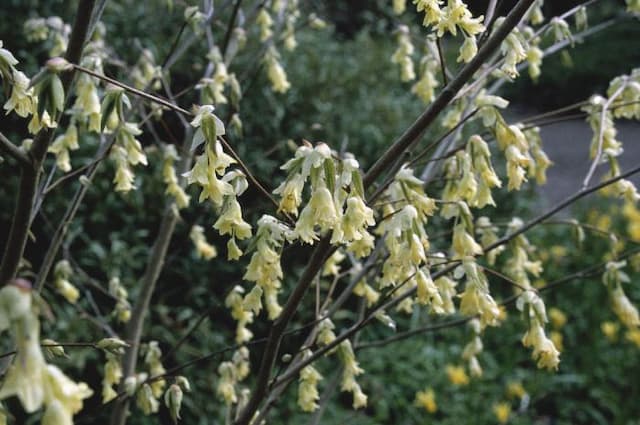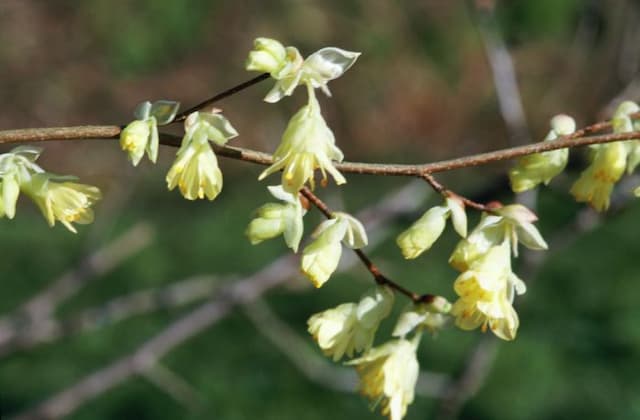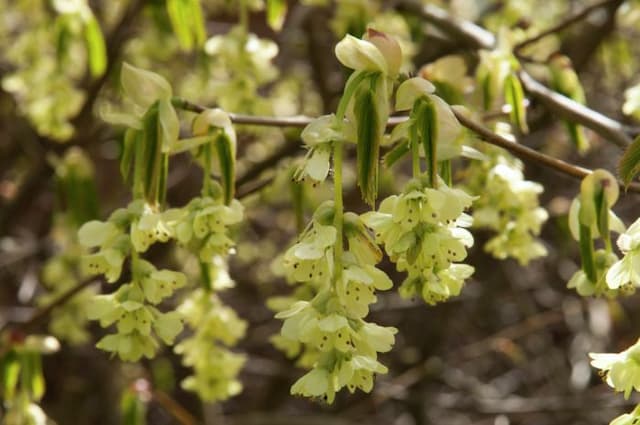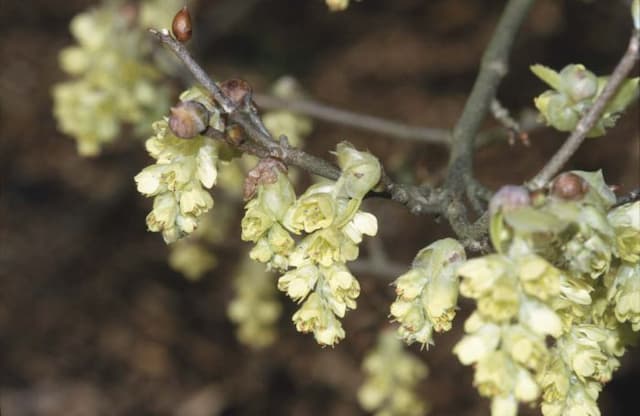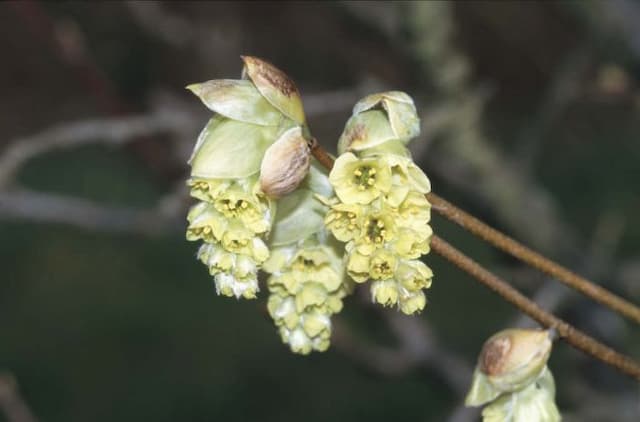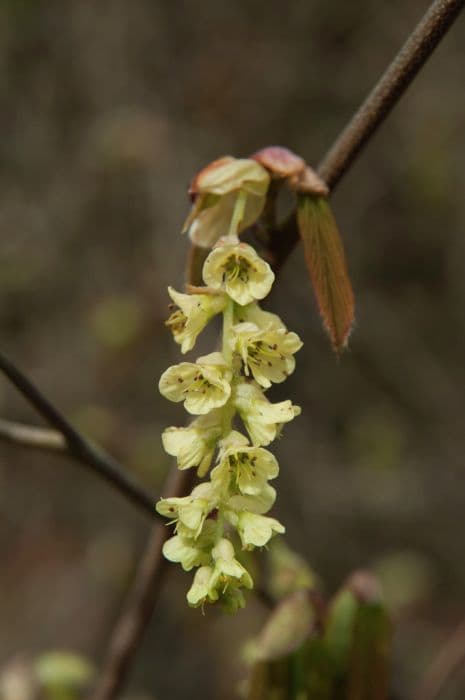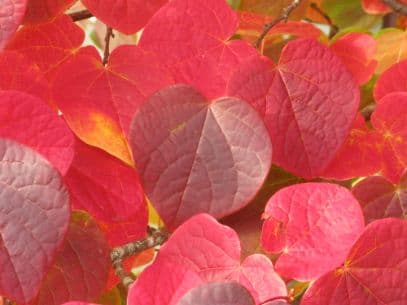Mount Airy Fothergilla Fothergilla × intermedia 'Mount Airy'

ABOUT
Mount Airy Fothergilla is a deciduous shrub noted for its multi-season interest in the garden. It bears unique, fragrant, bottlebrush-like flowers that are white, appearing in spring before the leaves emerge. These flowers are composed of numerous fluffy stamens, lacking petals, which give the plant a soft, cottony texture. As the seasons progress, the foliage of Mount Airy Fothergilla unfolds into attractive, leathery leaves that are dark green on top with a bluish-green underside. The foliage is oval-shaped with distinctive, serrated edges that can add texture to the landscape. Come autumn, the leaves of the Mount Airy Fothergilla transform into a spectacular display of fiery colors ranging from bright yellows and oranges to deep reds, providing a stunning contrast against the backdrop of a fall garden. The overall form of the plant is mounded, with branches that may grow in a somewhat upright fashion, giving it a striking, architectural quality that enhances its ornamental value throughout the year.
About this plant
 Names
NamesSynonyms
Mount Airy Fothergilla, Mount Airy Witch Alder.
Common names
Fothergilla × intermedia 'Mount Airy'.
 Toxicity
ToxicityTo humans
Mount Airy Fothergilla is not known to be toxic to humans. However, it is always advisable to avoid ingesting parts of ornamental plants due to possible individual allergies or unanticipated reactions.
To pets
Mount Airy Fothergilla is not commonly known to be toxic to pets either. As with humans, it's generally best to prevent pets from consuming plants not intended for them to avoid any potential gastrointestinal upset or allergic reactions.
 Characteristics
CharacteristicsLife cycle
Perennials
Foliage type
Deciduous
Color of leaves
Green
Flower color
White
Height
4-5 feet (1.2-1.5 meters)
Spread
4-5 feet (1.2-1.5 meters)
Plant type
Shrub
Hardiness zones
5
Native area
Southeastern United States
Benefits
 General Benefits
General Benefits- Attractive Seasonal Foliage: Fothergilla 'Mount Airy' boasts striking spring and fall foliage, with leaves that emerge blue-green in spring and turn fiery shades of red, orange, and yellow in the fall.
- Decorative Flowers: The plant produces white, brush-like flowers in the spring that have a light, honey-like fragrance, adding both visual and olfactory appeal to gardens.
- Suitable for Small Spaces: 'Mount Airy' is a medium-sized shrub that fits well in smaller garden spaces or urban landscapes.
- Low Maintenance: It requires minimal pruning and is generally low maintenance, making it a good choice for both novice and experienced gardeners.
- Drought Tolerance: Once established, it has a good tolerance for drought, reducing the need for frequent watering.
- Pest and Disease Resistance: The plant has a natural resistance to many common pests and diseases, promoting a healthier and more robust garden environment.
- Attracts Pollinators: The flowers of Fothergilla 'Mount Airy' are attractive to bees and other pollinators, supporting biodiversity in the garden.
- Native Plant Advantages: As a plant native to the southeastern United States, it is well-adapted to the regional climate and supports local ecosystems.
- Soil Adaptability: 'Mount Airy' can adapt to a variety of soil types, although it prefers acidic, well-drained soils.
- Seasonal Interest: This plant provides year-round interest with spring flowers, summer foliage, fall color, and even interesting branch structure in the winter.
 Medical Properties
Medical PropertiesThis plant is not used for medical purposes.
 Air-purifying Qualities
Air-purifying QualitiesThis plant is not specifically known for air purifying qualities.
 Other Uses
Other Uses- Fothergilla 'Mount Airy' can be used in bonsai cultivation due to its interesting branch structure and attractive foliage.
- The plant's dried flowers can be used in potpourri mixes to add a unique texture and appearance.
- Its leaves, which show a vibrant display of fall colors, can be pressed and used in autumn-themed crafts and decorations.
- Fothergilla 'Mount Airy' can provide natural fencing when planted in a dense row, offering privacy with a decorative touch.
- The branches can be incorporated into rustic wreaths or other garden-inspired art projects.
- Fothergilla 'Mount Airy' can be used as a teaching tool for horticultural students learning about ornamental shrub cultivation and maintenance.
- The plant can serve as a natural dye source, where its leaves may produce subtle coloring agents for fabrics or crafts.
- Fothergilla 'Mount Airy' may be utilized in landscape photography to add depth and interest to garden scenes.
- During spring, its bottlebrush-like flowers can be a backdrop for macro photography, offering a unique texture and form for photographers.
- The shrub can act as a companion plant in orchards, providing varied blooming times that can help support a diverse pollinator population.
Interesting Facts
 Feng Shui
Feng ShuiMount Airy is not used in Feng Shui practice.
 Zodiac Sign Compitability
Zodiac Sign CompitabilityMount Airy is not used in astrology practice.
 Plant Symbolism
Plant Symbolism- Resilience: Mount Airy Witch Alder is known for its toughness and ability to withstand a variety of growing conditions, symbolizing resilience and adaptability in the face of challenges.
- Natural beauty: With its attractive foliage and bottlebrush-like flowers, Mount Airy Witch Alder is often associated with natural beauty and the notion of finding elegance in simplicity.
- Renewal: The plant's pattern of flowering in spring, followed by striking fall colors, represents the idea of renewal and the cycle of life, rebirth, and new beginnings.
- Transformation: As Mount Airy Witch Alder transitions through seasons with significant changes in appearance, it symbolizes personal growth and transformation.
 Water
WaterFor Mount Airy Fothergilla, ensure the soil is kept consistently moist but not waterlogged, especially during the first growing season to establish a deep root system. Watering should be done deeply once a week, providing about 1 gallon of water for each square yard of soil. During periods of drought or extreme heat, increase watering frequency to twice a week. In non-drought conditions, reduce watering to every other week once the plant is well-established. Adjust watering as needed during fall and winter when the plant is dormant, ensuring the soil does not become bone dry.
 Light
LightMount Airy Fothergilla thrives best in full sun to partial shade conditions. It should be planted in a spot where it receives at least six hours of direct sunlight daily, though it can tolerate some afternoon shade. The ideal location maximizes morning sunlight with some protection from intense late-day sun, especially in hotter regions.
 Temperature
TemperatureThe ideal temperature range for Mount Airy Fothergilla is between 60°F and 80°F. This plant is hardy and can tolerate temperatures down to about -10°F and withstand summers up to 90°F without much stress. However, prolonged exposure to extremes outside this range can damage the plant.
 Pruning
PruningMount Airy Fothergilla benefits from pruning to shape the plant, control its size, and remove any dead or damaged branches. The best time to prune is right after flowering in late spring to early summer, as the plant blooms on old wood. Annual light pruning is generally sufficient, but it can tolerate more extensive shaping every few years if necessary.
 Cleaning
CleaningAs needed
 Soil
SoilThe best soil mix for Mount Airy Fothergilla should be rich in organic matter, well-draining, with a slightly acidic to neutral pH of 5.0 to 7.0. A mix combining loamy soil, peat moss, and pine bark will support its growth.
 Repotting
RepottingMount Airy Fothergilla, being a shrub, is usually planted outdoors and does not require repotting. If grown in containers, repotting every 3-5 years or when root bound is sufficient.
 Humidity & Misting
Humidity & MistingMount Airy Fothergilla thrives in average humidity levels found in outdoor environments; it does not have specific high humidity requirements.
 Suitable locations
Suitable locationsIndoor
Not ideal for indoors; prefers outdoor settings.
Outdoor
Plant in sun to partial shade, moist soil, mulch, and space 4-6 feet apart.
Hardiness zone
5-9 USDA
 Life cycle
Life cycleWitch Alder (Fothergilla × intermedia 'Mount Airy') begins its life cycle when the seeds germinate, often in spring to early summer, after experiencing a period of cold stratification which breaks their dormancy. The seedling stage follows, where the plant establishes roots and shoots, setting the foundation for future growth. As it enters the vegetative stage, Witch Alder develops leaves and branches, increasing in size and creating the bushy structure characteristic of mature shrubs. Upon reaching maturity, often in a few growing seasons, the plant produces distinctive white, brush-like flowers in early spring before the leaves emerge. After pollination, typically by bees and other insects attracted to its fragrant flowers, the plant develops small capsules that contain seeds ready for dispersal in late summer to fall. This shrub goes dormant in winter, shedding leaves to conserve resources, completing the annual cycle which can repeat for many years, given that Witch Alder is a deciduous shrub that can live for several decades.
 Propogation
PropogationPropogation time
Early spring
The most popular method of propagation for Fothergilla x intermedia 'Mount Airy', commonly known as Mount Airy dwarf fothergilla, is through softwood cuttings taken in late spring or early summer. At this time, the plant is actively growing, and the new stems are mature enough yet still pliable, making them ideal for rooting. A cutting should be about 3 to 6 inches long with several leaves, and the lower leaves should be removed. It's important to make a clean cut just below a set of leaves, and it's beneficial to dip the cut end in a rooting hormone before planting it in a well-draining soil mix. The cutting should then be placed in a bright area out of direct sunlight and kept consistently moist but not waterlogged. Maintaining high humidity around the cutting by covering it with a plastic bag or dome can further enhance the rooting process. After several weeks, the cutting should develop roots and can be transplanted to a more permanent location.
